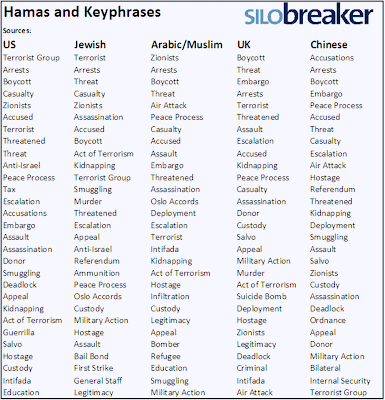Silobreaker provides more insightful results than traditional search engines by returning not just lists of headlines, but a fuller picture of people, places, companies, organizations, keyphrases, etc that are related or associated with each search result. This is a simple way of providing quick glances of instant “truthiness” that otherwise may require days if not weeks of manual research to work out.
Last week I took a look at what keywords each presidential candidate in the US was associated with and the differences between Democrats and Republicans.
Here is another way that Silobreaker can slice up the news flow. Let’s take a look at one of the most talked-about organizations in the Middle East right now – Hamas.
Q: Are there differences in the tonality of the reporting about Hamas between news sources from different countries?
I looked at sources from 5 different origins; US, Jewish, Arabic/Muslim, UK, and Chinese; their reporting around Hamas and especially what keyphrases and organizations that were associated to Hamas in such reporting (top of a list means the strongest association).
As I pointed out last week, this is not scientific research and may come with some obvious flaws (after all it took me all of 10 minutes). Real political commentators or media analysts may have very different views, but I guess one of the beauties with these truthiness reports is that they don’t take any views. They find what they find without any bias and leave the interpretation to others. Users may also find that these search results trigger questions and ideas, otherwise not thought of, leading to more comprehensive research through Silobreaker’s many other tools and features (or elsewhere).
At a first glance at the lists below, many keywords seem to be the same regardless of the origin of the source (possibly because the keywords represent the issues -but to which there are often two sides). At a closer look, however, the lists suggest more than subtle differences both in terms of tonality and the order in which certain keywords are placed on the lists. The result also suggests that sources from origins not immediately involved have a more emotionally detached and diplomatic tone in their reporting.
For instance, “Terrorist Group” and “Terrorist” are the most strongly associated keywords to Hamas amongst US and Jewish sources, while such terms come much further down the list for Arabic/Muslim sources (16th place) and hardly at all for Chinese sources (29th place).



In some more detail
Roughly 3,000 unique news articles were found in Silobreaker from the sources above in which Hamas was mentioned. All articles were in English. Blogs were not included in the analysis above.
Please note that the advanced search functionality that I used in Silobreaker to obtain the results above is not yet deployed in the beta version. Advanced search is only available in our subscription service so far, but is due to be released in the beta soon.
The relationships or associations that Silobreaker extracts and visualizes are not pre-determined or manually configured in any way. Silobreaker deduces relationships between terms or entities statistically by computing several measurements, such as co-occurrences, text-proximity, spelling variations etc in the information flow. This enables Silobreaker to offer more insightful search results than just traditional lists of headlines (often too many) by showing people, companies, places, keyphrases, etc that are related or associated with the search results. This in turn enables the user to move away from linear analysis to multi-dimensional exploration and discovery.
Check it out at http://beta.silobreaker.com/
Kristofer Mansson, CEO


